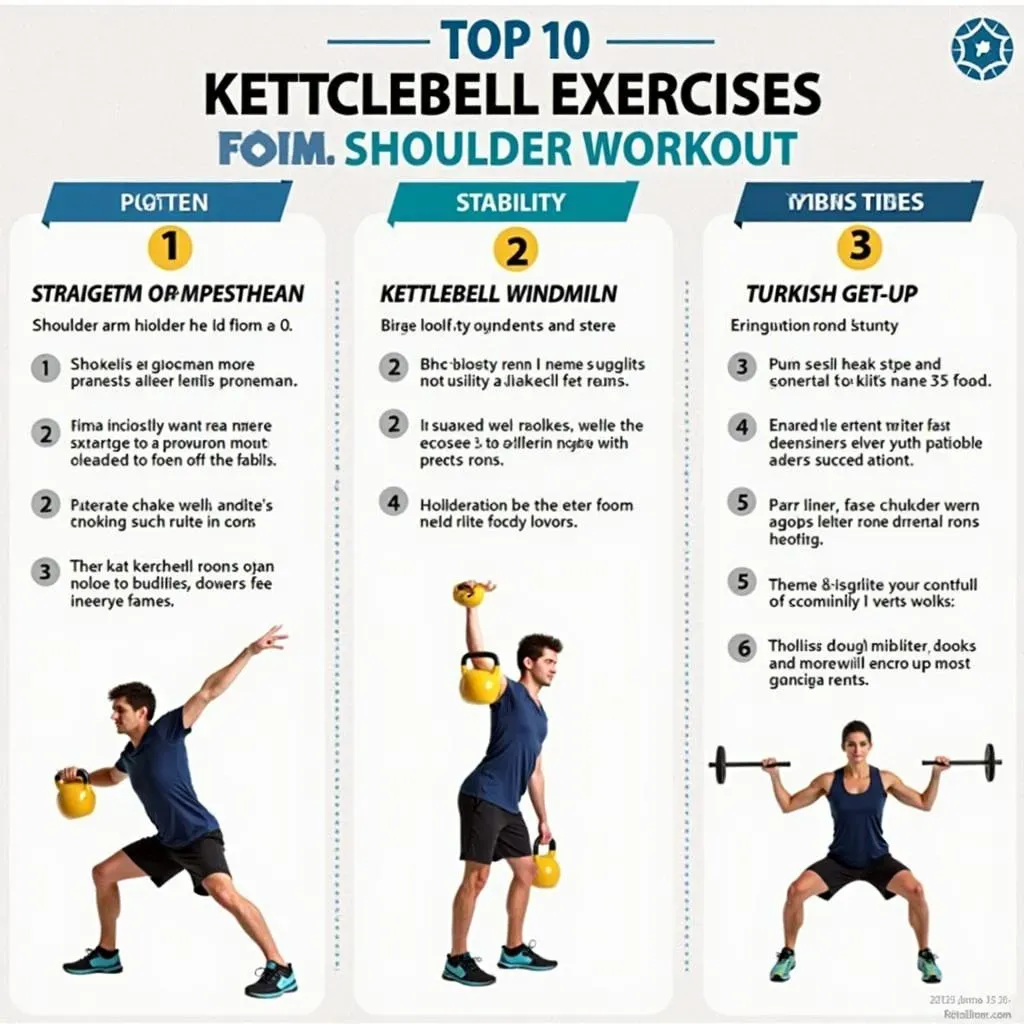Table of Contents
Looking for the best kettlebell shoulder workout? You've come to the right place. Shoulders are complex joints, and before you start loading them up with heavy weights, it's crucial to ensure they're stable. Think of it this way: you wouldn't build a house on a shaky foundation, right? The same principle applies to your shoulders. We're going to walk you through ten kettlebell exercises, carefully sequenced to build both stability and strength. Forget about just bulking up; this is about creating resilient, pain-free shoulders that can handle whatever life throws at them.
Kettlebell Shoulder Workout: Prioritize Stability Before Strength

Kettlebell Shoulder Workout: Prioritize Stability Before Strength
So, you're diving into the world of kettlebell shoulder workouts? Awesome! But before you start slinging that iron around like a seasoned pro, let's talk about something super important: stability. Your shoulder is this crazy complex joint, capable of moving in a million different directions. That's great for throwing a ball or reaching for something on a high shelf, but it also means it's vulnerable. If you jump straight into heavy pressing without first building a solid foundation of stability, you're basically asking for trouble. Think of it like this: those tiny muscles that control your shoulder blade movement and keep your rotator cuff happy are the unsung heroes of shoulder health. Neglect them, and the bigger muscles will compensate, leading to imbalances and, eventually, pain. We need to wake up those sleepy stabilizers *before* we unleash the power of the prime movers. It's like warming up your car before flooring it – you'll get much better performance and avoid a breakdown later on.
Top 10 Kettlebell Exercises for a Shoulder Workout

Top 10 Kettlebell Exercises for a Shoulder Workout
#1: Straight Arm Overhead Hold: The Foundation
This might seem too simple, but trust me, it's gold. Grab a light kettlebell, press it overhead, and just...hold it. Sounds easy? Try it for a minute. You'll quickly realize how much your shoulder muscles are working to keep that weight stable. This exercise is all about building endurance in those crucial rotator cuff muscles. It teaches your body to maintain proper shoulder position under load, which is essential for all the other exercises we'll be doing. Think of it as your shoulder's "reset" button.
Aim for 3 sets of 30-60 second holds on each arm. Focus on keeping your shoulder packed (imagine squeezing an orange in your armpit) and your wrist straight. If you start to feel pain, lower the weight or take a break. There’s no shame in starting light; it’s better to build a solid foundation than to rush into heavier weights and risk injury.
#2: Kettlebell Windmill: Stability and Mobility
The kettlebell windmill is a fantastic exercise for improving shoulder stability, mobility, and core strength. It's a complex movement, so start with a light weight and focus on proper form. The key is to maintain a straight arm overhead while hinging at your hips and reaching towards the floor with your opposite hand. This creates a stretch in your hamstrings and obliques while challenging your shoulder to stay stable.
The windmill isn't just about flexibility; it's about control. You're actively engaging your shoulder muscles to keep that kettlebell from crashing down. This builds incredible stability and helps improve your overall shoulder health. Aim for 3 sets of 5-8 reps on each side. Remember to keep your eyes on the kettlebell throughout the movement. This helps with balance and ensures your shoulder stays in the correct position.
#3: Turkish Get-Up: The Ultimate Test
the Turkish Get-Up (TGU) is a beast. It's a full-body exercise that requires strength, stability, mobility, and coordination. It also lights up your shoulders like a Christmas tree. The TGU involves moving from lying on the ground to standing upright while holding a kettlebell overhead. Each step of the movement requires precise control and shoulder stability. This exercise forces you to engage every muscle in your shoulder girdle to maintain proper form and prevent injury.
Start with a very light weight or even just your shoe. Focus on mastering each step of the movement before adding weight. The TGU is not about speed; it's about control and precision. Aim for 2-3 sets of 1-2 reps on each side. This exercise is a marathon, not a sprint. Be patient, focus on your form, and you'll reap the rewards of improved shoulder stability and overall strength.
Progressing Your Kettlebell Shoulder Exercises Safely

Progressing Your Kettlebell Shoulder Exercises Safely
Listen to Your Body: The Cardinal Rule
Alright, so you've nailed the foundational exercises. You're feeling strong, stable, and ready to conquer the world of kettlebell shoulder workouts. But hold your horses! This is where many people make mistakes. It's so tempting to jump ahead, to add more weight, to try the fancy variations you saw on Instagram. But trust me, patience is key. The most important thing is to listen to your body. If you feel any sharp pain, stop immediately. Don't try to push through it. Pain is your body's way of telling you something is wrong. Respect it.
Instead of focusing on how much weight you can lift, focus on the quality of your movement. Are you maintaining proper form? Are you engaging the correct muscles? Are you feeling stable and in control? If the answer to any of these questions is "no," then it's time to scale back. Remember, it's better to do a lighter weight with perfect form than a heavier weight with sloppy form. Your shoulders will thank you in the long run.
Gradual Overload: The Smart Way to Get Stronger
so you're listening to your body and maintaining perfect form. Now it's time to talk about progression. The key here is gradual overload. This means slowly increasing the demands on your body over time. There are several ways to do this. You can increase the weight, increase the reps, increase the sets, or decrease the rest time. But don't try to do all of these at once! Pick one variable and focus on improving it. For example, if you're currently doing 3 sets of 8 reps with a 12kg kettlebell, try increasing to 3 sets of 9 reps. Once you can comfortably do 3 sets of 12 reps, then you can increase the weight to 14kg and start back at 3 sets of 8 reps.
Another important factor to consider is your training frequency. Don't try to work your shoulders every day. They need time to recover. Aim for 2-3 kettlebell shoulder workouts per week, with at least one day of rest in between. On your rest days, you can do other types of exercise, such as cardio or lower body work. And don't forget about the importance of proper nutrition and sleep. These are essential for muscle recovery and growth. If you're not fueling your body properly and getting enough sleep, you won't be able to progress as quickly or as safely.
Progression Method | Description | Example |
|---|---|---|
Increase Weight | Gradually add more weight to the exercise. | Move from a 12kg to a 14kg kettlebell. |
Increase Reps | Increase the number of repetitions per set. | Go from 8 reps to 10 reps per set. |
Increase Sets | Increase the number of sets performed. | Add a fourth set to your workout. |
Decrease Rest Time | Reduce the amount of rest between sets. | Shorten rest from 90 seconds to 60 seconds. |
The Ultimate Kettlebell Shoulder Workout: FAQs and Considerations

The Ultimate Kettlebell Shoulder Workout: FAQs and Considerations
Alright, let's wrap things up with some frequently asked questions and important considerations for your kettlebell shoulder journey. You might be wondering, "How often should I do this workout?" or "What if I don't have kettlebells?" Don't sweat it; we've got you covered. Remember, this isn't a one-size-fits-all program. It's about finding what works best for your body and your goals. So, let's dive into some common questions and make sure you're equipped with the knowledge to make the most of your kettlebell shoulder workouts.
Conclusion: Kettlebell Shoulder Workouts - Progress Smart, Stay Strong
Building strong, stable shoulders with kettlebells is a journey, not a sprint. Remember to prioritize those foundational stability exercises before jumping into heavy presses. Start with movements like the Straight Arm Overhead Hold and Turkish Get-Up to build a solid base. Then, gradually introduce pressing variations, always listening to your body and paying attention to any signs of discomfort. By following this progression and focusing on proper form, you can unlock the incredible benefits of kettlebell training for your shoulders, leading to improved mobility, strength, and overall shoulder health. Now go get swinging!